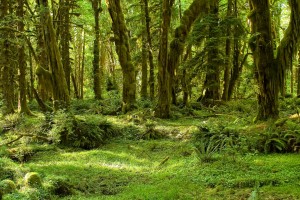The Olympic National Forest was established in 1907. It contains 256,440 acres of land historically used for timber and as a source of freshwater. In 1994, the National Forest Service implemented the Northwest Forest Plan to alter the ecosystem management and move towards restoration and protection of the forests. The focus is on managing and preserving the native biodiversity and the development of the forests, restoring and protection the aquatic ecosystems and managing for threatened and endangered species.
Climate Change has the potential to cause much damage, and the National Forest Service has come up with a response plan:
Response to increased invasive species–>Early detection and rapid response; Increased exotic species control efforts
Response to re-generation failures after large disturbances–> Develop gene-conservation plan for long-term storage; Maintain tree-seed inventory for as many tree species possible; Increase production of native plant materials for post flood planting
Response to increased drought–> Increased thinning to reduce stress on forests; Prescribed fires
Response to altered eco-system structure and potential disruption of process and function–> Prioritize actions that will help maintain ecosystem function; Focus on actions that will help minimize mass die-off and effects of major disturbances; Create structures and processes that are viable over the long term.
The effectiveness of this response plan is yet to be seen.

http://www.fs.fed.us/pnw/pubs/pnw_gtr844.pdf http://upload.wikimedia.org/wikipedia/commons/e/e1/Hoh_Rain_Forest,_Olympic_National_Park,_Washington_State,_1992.JPG http://upload.wikimedia.org/wikipedia/commons/5/5d/Maple_Glade_Trail,_Olympic_National_Park.jpg
Adapting to climate change at Olympic National Forest
Leave a Comment
Posted on April 28, 2014 by bejohnson
The Olympic National Forest was established in 1907. It contains 256,440 acres of land historically used for timber and as a source of freshwater. In 1994, the National Forest Service implemented the Northwest Forest Plan to alter the ecosystem management and move towards restoration and protection of the forests. The focus is on managing and preserving the native biodiversity and the development of the forests, restoring and protection the aquatic ecosystems and managing for threatened and endangered species.
Climate Change has the potential to cause much damage, and the National Forest Service has come up with a response plan:
Response to increased invasive species–>Early detection and rapid response; Increased exotic species control efforts
Response to re-generation failures after large disturbances–> Develop gene-conservation plan for long-term storage; Maintain tree-seed inventory for as many tree species possible; Increase production of native plant materials for post flood planting
Response to increased drought–> Increased thinning to reduce stress on forests; Prescribed fires
Response to altered eco-system structure and potential disruption of process and function–> Prioritize actions that will help maintain ecosystem function; Focus on actions that will help minimize mass die-off and effects of major disturbances; Create structures and processes that are viable over the long term.
The effectiveness of this response plan is yet to be seen.
http://www.fs.fed.us/pnw/pubs/pnw_gtr844.pdf http://upload.wikimedia.org/wikipedia/commons/e/e1/Hoh_Rain_Forest,_Olympic_National_Park,_Washington_State,_1992.JPG http://upload.wikimedia.org/wikipedia/commons/5/5d/Maple_Glade_Trail,_Olympic_National_Park.jpg
Category: Pacific Northwest Issues
Recent Posts
Recent Comments
Archives
Categories
Meta